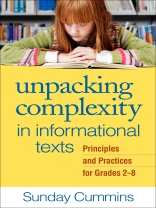To acquire content knowledge through reading, students must understand the complex components and diverse purposes of informational texts, as emphasized in the Common Core State Standards (CCSS). This practical book illuminates the ways in which a text’s purpose, structure, details, connective language, and construction of themes combine to create meaning. Classroom-tested instructional recommendations and ‘kid-friendly’ explanations guide teachers in helping students to identify and understand the role of these elements in different types of informational texts. Numerous student work samples, excerpts from exemplary books and articles, and a Study Guide with discussion questions and activities for professional learning add to the book’s utility.
Table of Content
Introduction. The Issue of Informational Text Complexity
1. What Do We Mean by Text Complexity?
2. What Makes an Informational Text Complex?
3. What Do We Mean by an Author’s Purpose?
4. What Do We Mean by a Text’s Structure?
5. What Types of Details Are in Non-Narrative Texts?
6. What Types of Details Are in Narrative Texts?
7. Why Pay Attention to Connective Language?
8. How Are Main Ideas Constructed?
Closing Thoughts
Appendix. Study Guide
About the author
Sunday Cummins, Ph D, is an independent literacy consultant who lives in Chico, California, and consults nationally. Formerly she was Assistant Professor of Education in the Reading and Language Department at National Louis University and a facilitator for the New Schools Project at the Erikson Institute in Chicago. Before becoming a professor, Dr. Cummins worked in the public schools for 10 years as a middle school and third-grade teacher and as a literacy coach. She is the author of Close Reading of Informational Texts as well as articles in The Reading Teacher and Talking Points, and shares her work on teaching with informational texts by presenting at state, national, and international conferences. Her website is www.Sunday-Cummins.com.












